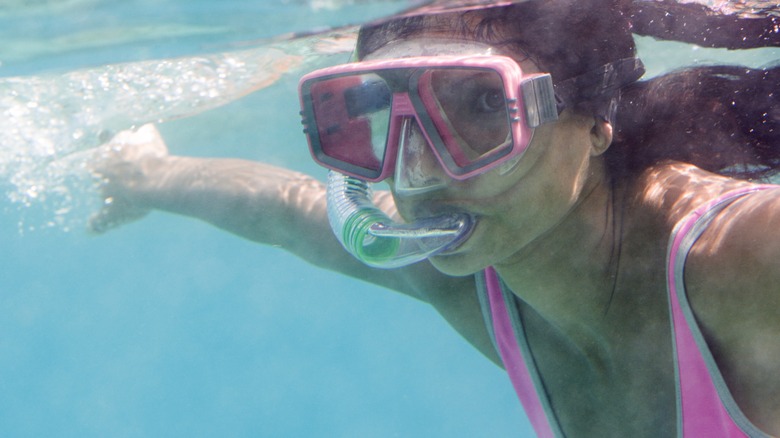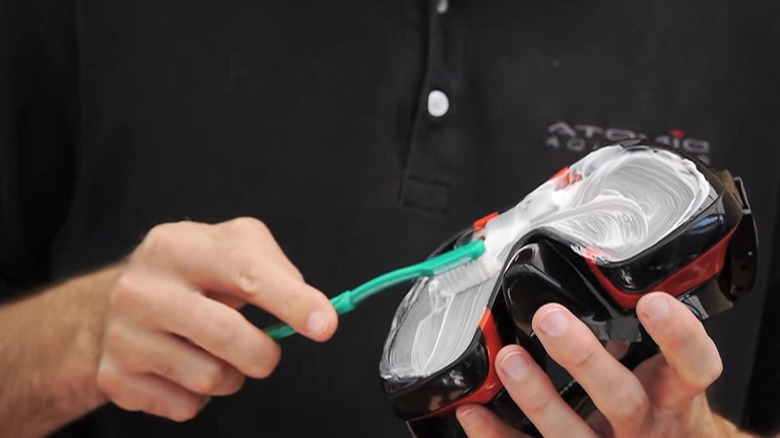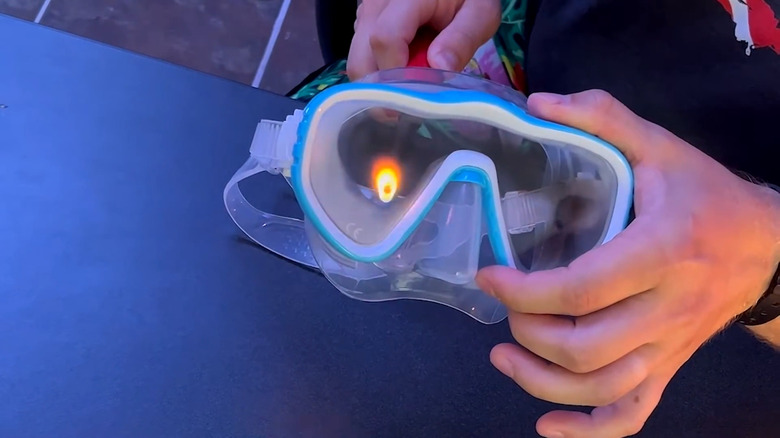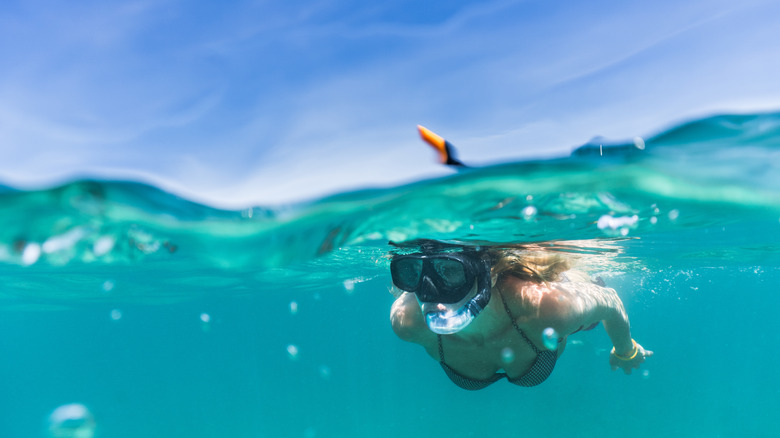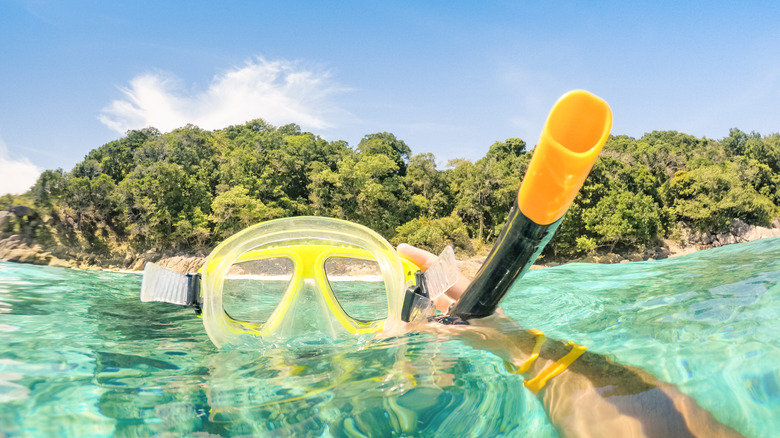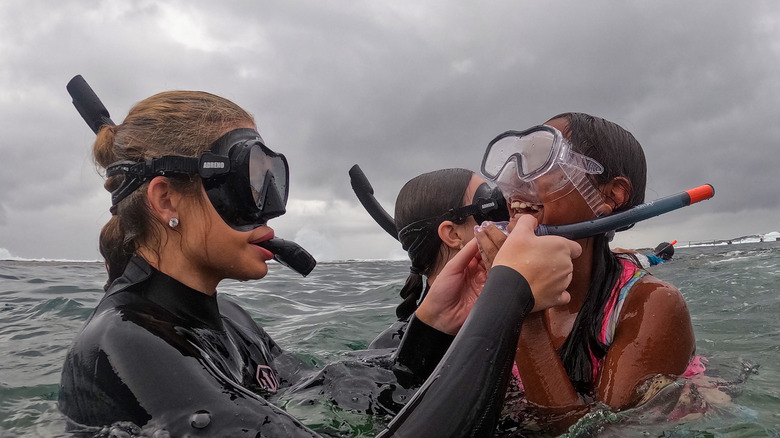Get Rid Of Fog In Your Snorkel Mask With These Tricks
When you go snorkeling, you get to see a rare glimpse of the incredible hidden world beneath the waves. A fogged-up mask can ruin that experience. You can definitely flood and clear your mask to get rid of the fog temporarily, but unfortunately, having water coming into your mask regularly will only make the fog worse in the long run. Fortunately, just like you can practice snorkeling, learn how to pick the best spots, and swim safely through gorgeous coral reefs, you can also learn how to keep your mask clear so that you don't miss a thing.
There are two main reasons a snorkeling mask may be cloudy. The first is that it's brand new. As frustrating as it might be to have your mask need cleaning right out of the box, they typically come with a cloudy film on the lenses that make it tricky to see. If you've already used your mask, it probably still needs a cleaning to keep condensation from building up while you're snorkeling. Here are some of the best strategies for getting rid of the fog.
Rub toothpaste on it
When you first get a new scuba or snorkel mask with glass lenses, there might be some greasy film from the manufacturing process left behind on the lenses. While that's not true of every mask, if you're noticing fogging on a brand-new mask, that's probably what's going on. Snorkelers have a lot of unique methods for taking care of this gunk that range from scrubbing it with a stain remover made from diamond dust to pouring a can of Coca-Cola on it – but the most popular tool for cleaning a brand-new mask is definitely ordinary toothpaste.
For this technique to work, you want to use the most basic toothpaste you can. It should be white (a paste, not a gel) and have silica on the ingredient list. All you need to do is squeeze some out onto the lenses of your mask, rub it all over the inside and outside of the lenses, and then leave it overnight. The next day, you can rinse it off in the sink, and your new mask should be good to go.
Burn it up
One classic strategy for removing chemical film from glass lenses on snorkeling or scuba diving masks is to hold it very close to the flame from a lighter. This technique definitely works, but it is very controversial since it's easy to accidentally melt the plastic parts of your brand-new mask while doing it (or burn yourself!). Many experienced snorkelers swear by this method and it is often considered the fastest and most effective way to get your mask fog-free and ready to use, so you can decide for yourself whether it's worth the risk.
When using this technique, often called flaming, all you have to do is take a lighter to the inside of your glass lenses, being careful not to heat up the plastic parts of the mask or touch the flame to the outside of your lenses. When the glass turns black, stop and clean off the soot. The mask should be ready for use after just one burn, though some advise doing this process again just to be certain you've removed all of the silicone.
Keep it clean
If you've already been using your mask without issue for a while, and now it's suddenly fogging up, it probably needs a more thorough cleaning. While it might look clean, even tiny amounts of the oil from your skin can cause moisture that gets into your mask to build up on your lenses, blocking your view instead of pooling in the bottom where it belongs. Even just quickly rinsing your mask when you finish snorkeling can help prevent this, but every now and then, you'll have to give it a more thorough washing out to keep your vision clear.
Cleaning your snorkel mask doesn't have to be complicated. If your mask needs a good disinfecting, you can leave it in a 1% bleach solution for a couple of minutes. You can also simply wash it with soap and water like you would a dish. In fact, many prefer to use a dish detergent to clean their masks, as it not only cleans but can act as a defogger as well. Just make sure to rinse thoroughly. Some prefer to use baby shampoo, as it's less painful if any residual soap gets in your eyes while you're underwater.
Spit in your mask
Is this tip gross? Yes. Does it work? Also yes. If you're about to go into the water and your mask is fogging up, a layer of slightly viscous moisture, like human saliva, can help to keep it from fogging up. In fact, a lot of diving and snorkeling enthusiasts say that spitting into your lenses, swirling it around, and then rinsing it out with clean water is the single most effective thing they can put on their mask to keep it from fogging up.
The obvious downside of this is that our mouths aren't clean, and leaving bacteria to grow in a moist environment over time is definitely nasty and potentially dangerous. Bacteria growing in your mask can cause it to break down more quickly, so you'll have to replace it sooner than you expected – and you really don't want to be wearing a petri dish on your face, either. If you want to use this quick and dirty technique, definitely take the time to clean your mask extra well after each use.
Buy anti-fog
Let's face it: Fog blocking your view is frustrating. If you don't want to take a chance that you won't be able to see anything while you're inches away from a gorgeous coral reef, you may want to consider buying a product specifically designed to keep masks from fogging up in the water. Fortunately, there are a range of options available, and most of them won't break the bank.
You can purchase bottles of anti-fog sprays that you spritz onto your mask or de-fog gels that you squeeze out and rub into your lenses before dives for less than $10. Afterwards, all you have to do is rinse your mask and you're ready to get in the water. There are also anti-fog films available for some types of masks that you can purchase for around $20 and install on your lenses yourself. These will still need to be cleaned regularly but should lower the risk of your view being obstructed by condensation.
